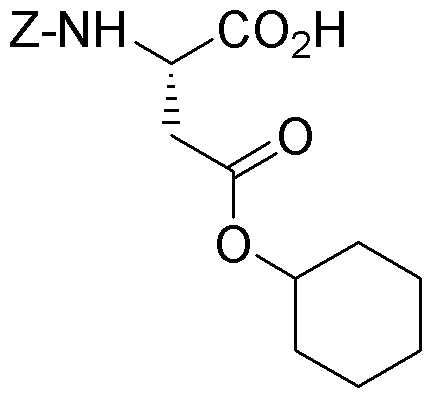Z-L-aspartic acid b-cyclohexyl ester is widely utilized in research focused on
- Pharmaceutical Development: This compound serves as a key intermediate in the synthesis of various pharmaceuticals, particularly those targeting neurological disorders. Its unique structure allows for enhanced bioactivity and specificity.
- Peptide Synthesis: It is commonly used in the production of peptides, which are essential in drug formulation and biological research. The cyclohexyl group improves the stability and solubility of peptides, making them more effective.
- Biochemical Research: Researchers employ this compound to study metabolic pathways and enzyme interactions. Its ability to mimic natural substrates aids in understanding complex biochemical processes.
- Cosmetic Formulations: The compound is also explored in the cosmetic industry for its potential anti-aging properties. Its incorporation into skincare products can enhance skin hydration and elasticity.
- Agricultural Applications: Z-L-aspartic acid b-cyclohexyl ester is being investigated for use in agrochemicals, particularly as a plant growth regulator. Its ability to influence plant metabolism can lead to improved crop yields.
General Information
Properties
Safety and Regulations
Applications
Z-L-aspartic acid b-cyclohexyl ester is widely utilized in research focused on
- Pharmaceutical Development: This compound serves as a key intermediate in the synthesis of various pharmaceuticals, particularly those targeting neurological disorders. Its unique structure allows for enhanced bioactivity and specificity.
- Peptide Synthesis: It is commonly used in the production of peptides, which are essential in drug formulation and biological research. The cyclohexyl group improves the stability and solubility of peptides, making them more effective.
- Biochemical Research: Researchers employ this compound to study metabolic pathways and enzyme interactions. Its ability to mimic natural substrates aids in understanding complex biochemical processes.
- Cosmetic Formulations: The compound is also explored in the cosmetic industry for its potential anti-aging properties. Its incorporation into skincare products can enhance skin hydration and elasticity.
- Agricultural Applications: Z-L-aspartic acid b-cyclohexyl ester is being investigated for use in agrochemicals, particularly as a plant growth regulator. Its ability to influence plant metabolism can lead to improved crop yields.
Documents
Safety Data Sheets (SDS)
The SDS provides comprehensive safety information on handling, storage, and disposal of the product.
Product Specification (PS)
The PS provides a comprehensive breakdown of the product’s properties, including chemical composition, physical state, purity, and storage requirements. It also details acceptable quality ranges and the product's intended applications.
Certificates of Analysis (COA)
Search for Certificates of Analysis (COA) by entering the products Lot Number. Lot and Batch Numbers can be found on a product’s label following the words ‘Lot’ or ‘Batch’.
*Catalog Number
*Lot Number
Certificates Of Origin (COO)
This COO confirms the country where the product was manufactured, and also details the materials and components used in it and whether it is derived from natural, synthetic, or other specific sources. This certificate may be required for customs, trade, and regulatory compliance.
*Catalog Number
*Lot Number
Safety Data Sheets (SDS)
The SDS provides comprehensive safety information on handling, storage, and disposal of the product.
DownloadProduct Specification (PS)
The PS provides a comprehensive breakdown of the product’s properties, including chemical composition, physical state, purity, and storage requirements. It also details acceptable quality ranges and the product's intended applications.
DownloadCertificates of Analysis (COA)
Search for Certificates of Analysis (COA) by entering the products Lot Number. Lot and Batch Numbers can be found on a product’s label following the words ‘Lot’ or ‘Batch’.
*Catalog Number
*Lot Number
Certificates Of Origin (COO)
This COO confirms the country where the product was manufactured, and also details the materials and components used in it and whether it is derived from natural, synthetic, or other specific sources. This certificate may be required for customs, trade, and regulatory compliance.


